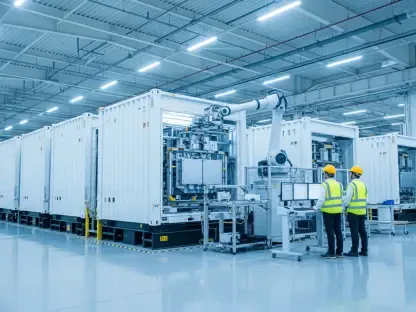In today’s conversation, we’re joined by Christopher Hailstone, a seasoned expert in energy management and renewable energy. Christopher has an extensive background in utilities, grid reliability, and security, offering valuable insights into the evolving landscape of renewable fuels. Our discussion covers the challenges facing Iowa’s ethanol industry, strategies for increasing demand, impacts on the economy, and the potential of ultra-low carbon markets. Let’s dive into what these changes mean for the future of renewable energy in Iowa.
What factors contributed to the $800 million decrease in economic impact for the renewable fuels industry in Iowa from 2023 to 2024?
The decrease can be attributed to stagnant corn demand combined with a reduction in job numbers. While Iowa produced record amounts of biofuels, the demand for corn didn’t increase accordingly, leading to economic constraints. There’s also the impact of construction projects wrapping up, and the closure of certain facilities, which contributed to this decline. The multiplier effect is another significant factor; without substantial demand, less money flows through the local economy, affecting jobs and spending in related areas.
Can you explain what you mean by “stagnant corn demand”? How has this stagnation specifically impacted the ethanol industry in Iowa?
Stagnant corn demand refers to a situation where corn production outpaces corn consumption, causing prices to drop due to oversupply. In the ethanol industry, this impacts Iowa producers financially and threatens the profitability of ethanol production as their primary input costs are heavily tied to corn prices. When demand continues to stall, it’s harder for farmers and producers to justify investments in new equipment or expansion, which further strains the broader agricultural and ethanol sector.
How do you propose entry to the ultra-low carbon ethanol markets will help increase corn demand?
The ultra-low carbon ethanol markets present a growth opportunity as they align with global trends towards sustainability and carbon reduction. By leveraging these markets, Iowa can expand its reach and increase demand for corn by unlocking novel applications for ethanol. These markets require ethanol to be produced with lower greenhouse gas emissions, enticing producers to invest in cleaner practices that ultimately boost corn demand as part of sustainable fuel production.
You mentioned record fuel production despite the challenges. What are the key factors driving this continued production?
One key factor is the resilience and efficiency improvements made by Iowa’s farmers and ethanol producers. They continue to maximize output using fewer resources, contributing to record production levels. Innovation within farming practices, access to advanced technology, and optimizing land use help sustain high productivity. Additionally, there’s been strategic focus on maintaining operational efficiency amidst declining prices, ensuring that production remains not only steady but record-breaking.
The study states that biofuels account for 2 percent of Iowa’s gross domestic product. What was the percentage in the previous year, and what does this indicate about the industry’s growth or decline?
Previously, biofuels contributed more significantly to Iowa’s GDP, suggesting a relative downturn in their economic role. This shift highlights challenges in the sector, mainly driven by the aforementioned stagnant corn demand and job reductions. While direct impacts remain robust, it indicates a need to bolster market demand to reclaim and expand its GDP share, especially through renewable fuel initiatives and expansions into new markets.
What are the causes behind the reduction in jobs from 52,000 in 2023 to over 34,000 in 2024?
The reduction in jobs stems from multiple factors including completed construction projects and facility closures. More crucially, indirect impacts related to stagnant demand for corn negatively affect various sectors. When farmers earn less, spending across the local economy diminishes as they postpone purchases like equipment or services, leading to job losses in those sectors that support agricultural activity.
How do indirect impacts contribute to the changes in job numbers? Can you provide examples of such impacts?
Indirect impacts occur when economic factors ripple through related industries beyond immediate production changes. For example, when corn prices are low, farmers hold back investments in machinery, trimming revenues for equipment manufacturers and dealers. This cascade effect can also be seen in reduced ancillary services like maintenance and transportation, as well as decreased spending within local communities, impacting retail and service jobs.
With corn prices decreasing over the past two years, how are farmers adapting to sustain their operations?
Farmers are taking adaptive approaches, such as refining their operational efficiency and leveraging technology to reduce input costs while maximizing yields. Many are turning to precision agriculture techniques to better manage resources. Additionally, they’re exploring alternative income channels, including energy markets like sustainable fuels and diversifying their crops to ensure stability amidst fluctuating commodity prices.
Ryan Sauer mentioned that if current trends continue, Iowa might face a crisis similar to the farm crisis of the 1980s. What parallels do you see between the current situation and the 1980s crisis?
The parallels lie in the economic pressure on farmers due to stagnating commodity prices against rising input costs, similar to the 1980s situation where many farmers struggled under mounting debt and unfavorable market conditions. Just like back then, the necessity to innovate and adapt quickly is crucial to prevent financial distress. Current challenges call for new market strategies and policy shifts to prevent repeating history.
What are the advantages of nationwide, year-round E15 implementation for Iowa farmers and the ethanol industry?
Year-round E15 implementation offers a substantial domestic demand boost. By increasing the ethanol blend to 15 percent, it promises a significant rise in corn consumption, supporting Iowa farmers directly. It helps stabilize demand, mitigating the impact of fluctuating exports due to tariffs. Moreover, E15 can make Iowa producers more competitive as it could lead to higher sustained ethanol sales, expanding economic opportunities.
What challenges do tariffs pose for Iowa corn exports, and how can increased domestic demand through methods like E15 help?
Tariffs create unpredictability and price instability in export markets, reducing Iowa’s corn competitiveness internationally. Increased domestic demand through E15 serves as a buffer against export uncertainties, ensuring that excess production finds reliable outlets within the U.S. Fueling domestic markets reduces dependency on volatile global markets, offering a more consistent revenue stream to farmers and ethanol producers.
Beyond E15, what are the potential low carbon markets for Iowa ethanol producers?
For Iowa producers, sustainable aviation fuel represents a significant low carbon market. Additionally, there are emerging opportunities in the marine and rail sectors, where green fuels are gaining traction. Continued focus on low carbon certifications and practices can open doors to various transportation industries seeking to reduce environmental footprints, ultimately broadening the fillip for Iowa-produced ethanol.
What role does sustainable aviation fuel play in the low carbon market strategy, and how can Iowa contribute to this area?
Sustainable aviation fuel plays a massive role as airlines aggressively seek to reduce carbon emissions. Iowa can contribute by leading innovation in ethanol production methods that lower carbon intensity, which is crucial for aviation fuel standards. Embracing environmentally friendly feedstock and implementing carbon sequestration projects can further position Iowa as a pivotal player in supplying low carbon aviation fuels.
In regards to carbon intensity, what steps can ethanol producers take to lower it? How essential is carbon capture and sequestration in this regard?
Ethanol producers can adopt carbon-reducing farming practices, optimize energy use during production, and enhance lifecycle assessments to lower carbon intensity. Carbon capture and sequestration is vital as it directly addresses emissions, providing the vast reductions necessary to meet ultra-low carbon fuel standards. Establishing these systems promises market expansion contingent on reduced greenhouse gas outputs.
Opposition to carbon dioxide sequestration pipelines is evident. How do you address concerns about safety and land use that opponents have raised?
Addressing safety concerns involves rigorous regulatory compliance and technological advances in pipeline safety. Transparent communication on safety protocols and ongoing monitoring can help alleviate fears. Regarding land use, engaging directly with landowners to negotiate fair terms and emphasizing benefits like long-term economic gains can mitigate opposition. It’s crucial to balance environmental objectives with community impact considerations.
How critical are the carbon dioxide sequestration capabilities of projects like the Summit Carbon Solutions pipeline to Iowa’s status as a leader in ethanol production?
These projects are critical as they offer competitive advantages in reducing the carbon footprint of ethanol production, aligning with market trends toward greener fuels. Without access to these capabilities, Iowa risks falling behind in scoring low carbon markets, potentially losing its leadership in efficient corn-to-ethanol conversion to regions that are advancing carbon mitigation strategies more rapidly.
Emma Schmit suggested other ways to expand markets via decarbonization without relying on pipelines. Can you discuss some alternatives?
Alternatives include advancing feedstock innovation, such as utilizing cover crops that improve soil carbon sequestration, or enhancing biorefinery processes to minimize emissions. Investing in agroforestry and renewable energy integration within production facilities are also viable strategies. These directions offer sustainable decarbonization that collaborates with ecosystems rather than depending solely on pipeline infrastructure.
What are the implications if Iowa loses its title as the “most cost-effective place to turn corn into ethanol”?
Losing this title could have substantial economic repercussions. It might shift investments and industry focus to neighboring states, reducing job opportunities and potentially increasing operational costs as Iowa’s competitive advantages wane. Additionally, it could lead to diminished influence in shaping ethanol policies or contributing to national dialogues on renewable energy solutions.
How does the political landscape affect decisions related to ethanol production and carbon capture initiatives?
The political landscape extensively influences policy-making and investment allocation. Supportive legislation can foster expansion of new markets like E15, and determine the viability of carbon capture projects. Political priorities can also sway public perception and funding towards sustainable practices, emphasizing the importance of collaboration with policymakers to align strategic industry goals with broader environmental and economic incentives.
Do you have any advice for our readers?
Stay informed on the multifaceted aspects of renewable energy, including technological developments and policy shifts. Advocate for sustainable practices, and recognize the interconnectedness of agricultural and energy sectors. Locally, support initiatives that foster market growth while emphasizing environmental stewardship. Remember, the renewable energy transition is a collective journey requiring innovative thinking and constructive collaboration.









